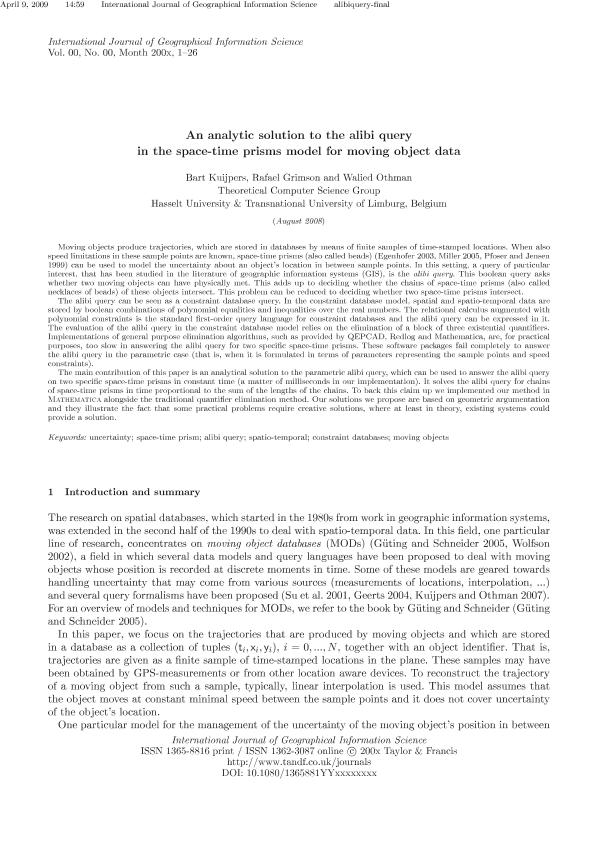Mostrar el registro sencillo del ítem
dc.contributor.author
Kuijpers, Bart
dc.contributor.author
Grimson, Rafael

dc.contributor.author
Othmans, Walied
dc.date.available
2019-01-15T21:35:54Z
dc.date.issued
2011-02
dc.identifier.citation
Kuijpers, Bart; Grimson, Rafael; Othmans, Walied; An analytic solution to the alibi query in the space-time prisms model for moving object data; Taylor & Francis; International Journal Of Geographical Information Science; 25; 2; 2-2011; 293-322
dc.identifier.issn
1365-8816
dc.identifier.uri
http://hdl.handle.net/11336/68097
dc.description.abstract
Moving objects produce trajectories, which are stored in databases by means of finite samples of time-stamped locations. When speed limitations in these sample points are also known, space-time prisms (also called beads) (Pfoser and Jensen 1999, Egenhofer 2003, Miller 2005) can be used to model the uncertainty about an object's location in between sample points. In this setting, a query of particular interest that has been studied in the literature of geographic information systems (GIS) is the alibi query. This boolean query asks whether two moving objects could have physically met. This adds up to deciding whether the chains of space-time prisms (also called necklaces of beads) of these objects intersect. This problem can be reduced to deciding whether two space-time prisms intersect. The alibi query can be seen as a constraint database query. In the constraint database model, spatial and spatiotemporal data are stored by boolean combinations of polynomial equalities and inequalities over the real numbers. The relational calculus augmented with polynomial constraints is the standard first-order query language for constraint databases and the alibi query can be expressed in it. The evaluation of the alibi query in the constraint database model relies on the elimination of a block of three existential quantifiers. Implementations of general purpose elimination algorithms, such as those provided by QEPCAD, Redlog, and Mathematica, are, for practical purposes, too slow in answering the alibi query for two specific space-time prisms. These software packages completely fail to answer the alibi query in the parametric case (i.e., when it is formulated in terms of parameters representing the sample points and speed constraints). The main contribution of this article is an analytical solution to the parametric alibi query, which can be used to answer the alibi query on two specific space-time prisms in constant time (a matter of milliseconds in our implementation). It solves the alibi query for chains of space-time prisms in time proportional to the sum of the lengths of the chains. To back this claim up, we implemented our method in Mathematica alongside the traditional quantifier elimination method. The solutions we propose are based on the geometric argumentation and they illustrate the fact that some practical problems require creative solutions, where at least in theory, existing systems could provide a solution.
dc.format
application/pdf
dc.language.iso
eng
dc.publisher
Taylor & Francis

dc.rights
info:eu-repo/semantics/openAccess
dc.rights.uri
https://creativecommons.org/licenses/by-nc-sa/2.5/ar/
dc.subject
Alibi Query
dc.subject
Constraint Databases
dc.subject
Moving Objects
dc.subject
Space-Time Prism
dc.subject
Spatiotemporal
dc.subject
Uncertainty
dc.subject.classification
Geografía Física

dc.subject.classification
Ciencias de la Tierra y relacionadas con el Medio Ambiente

dc.subject.classification
CIENCIAS NATURALES Y EXACTAS

dc.title
An analytic solution to the alibi query in the space-time prisms model for moving object data
dc.type
info:eu-repo/semantics/article
dc.type
info:ar-repo/semantics/artículo
dc.type
info:eu-repo/semantics/publishedVersion
dc.date.updated
2019-01-14T17:58:02Z
dc.journal.volume
25
dc.journal.number
2
dc.journal.pagination
293-322
dc.journal.pais
Reino Unido

dc.journal.ciudad
Londres
dc.description.fil
Fil: Kuijpers, Bart. Hasselt University; Bélgica
dc.description.fil
Fil: Grimson, Rafael. Hasselt University; Bélgica. Consejo Nacional de Investigaciones Científicas y Técnicas; Argentina
dc.description.fil
Fil: Othmans, Walied. Hasselt University; Bélgica
dc.journal.title
International Journal Of Geographical Information Science

dc.relation.alternativeid
info:eu-repo/semantics/altIdentifier/doi/http://dx.doi.org/10.1080/13658810902967397
dc.relation.alternativeid
info:eu-repo/semantics/altIdentifier/url/https://www.tandfonline.com/doi/abs/10.1080/13658810902967397
Archivos asociados
